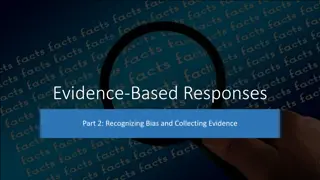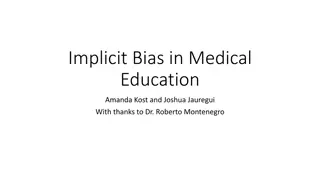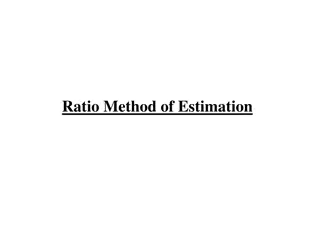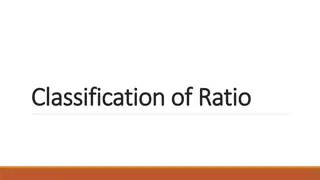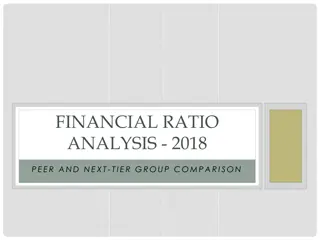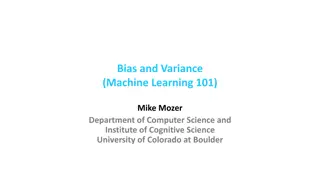Understanding Odds Ratio and Bias in Case-Control Studies
This educational material covers the essentials of odds ratio and bias in case-control studies, including how to construct a 2x2 table, calculate odds ratio, define bias, and interpret results. A specific case study on pesticide exposure and cancer is presented to illustrate these concepts. Readers will learn the importance of odds ratio in determining the association between exposure and disease risk.
Download Presentation

Please find below an Image/Link to download the presentation.
The content on the website is provided AS IS for your information and personal use only. It may not be sold, licensed, or shared on other websites without obtaining consent from the author. Download presentation by click this link. If you encounter any issues during the download, it is possible that the publisher has removed the file from their server.
E N D
Presentation Transcript
Odds Ratio& Bias in case-control studies Dr. Dr. Salwa Salwa A. Tayel Department of Family & Community medicine Department of Family & Community medicine October October- -2014 A. Tayel Dr. Dr. Armen Armen 2014 1
OBJECTIVES OF THE LECTURE OBJECTIVES OF THE LECTURE At the end of the session students should be able to: 1. Construct a 2X2 table to present findings of a case control study 2. Calculate and interpret the odds ratio in case control studies 3. Define bias 4. Know the common types of bias in case control studies 2
A case-control study of association between pesticide exposure & cancer In a case-control study to examine the association between pesticide exposure and cancer, the researcher selected 1000 cancer patients and a same number of matched control of same age and sex. He detected 600 patients with history of exposure to pesticides among cases and 250 exposed among the controls. Construct a 2X2 table to present these findings? 3
2X2 Table Cancer 600 Controls 250 Total Exposed Not exposed Total 1000 1000 4
A case-control study of association between pesticide exposure & cancer Cancer Controls Exposure to pesticides 600 250 No Exposure to pesticides 400 750 Calculate Odds Ratio Calculate Odds ratio (cross product ratio)? 5
A case-control study of association between pesticide exposure & cancer Cancer Controls Exposure to pesticides 600 250 No Exposure to pesticides 400 750 Calculate Odds Ratio Odds ratio (cross product ratio)= 600*750/400*250= 4.5 6
Interpretation of (OR) odds ratio OR>1 OR=1 OR<1 Odds of exposure for cases are less than the odds of exposure for controls Odds comparison between cases and controls Odds of exposure for cases are greater than the odds of exposure for controls Odds of exposure are equal among cases and controls Exposure as a risk factor for the disease? Particular exposure is not a risk factor Exposure reduces disease risk (Protective factor) Exposure increases disease risk (Risk factor) 7
Definition of bias Any systematic error in an epidemiological study that results in an incorrect estimate of the association between exposure and disease 8
Common types of bias in case control studies Selection bias (sampling) bias Recall bias Interviewing bias 9
Selection(Sampling) bias The patients with the disease may be a biased sample (for example, patients referred to a teaching hospital, complicated cases) or the controls may be biased (for example, volunteers, different ages, sex or socioeconomic group). 10
Overcoming selection bias (1) A convenience sample sampled in the same way as the cases, for example, attending the same outpatient department. (2) Matching the controls may be a matched or unmatched random sample from the unaffected population. (3) Using two or more control groups. (4) Using a population based sample for both cases and controls. 11
Recall bias Cases (or ill) may remember exposures differently than controls (or healthy) Examples how Cases may remember exposure differently than controls 12
Recall bias In a case control study of congenital malformation, mothers are asked about their drug intake during pregnancy. Mothers of Children with malformation Controls Took drugs during pregnancy a b Did not take c d Mothers of children with malformations will remember past exposures better than mothers with healthy children Overestimation of a overestimation of OR 13
Recall bias In a case control study of childhood leukaemia, mothers are asked about their coffee consumption during pregnancy. Mothers of Leukemic Children Controls Coffee consumption a b Did not take c d Mothers whose children were diagnosed with leukaemia may underestimate their use of coffee during pregnancy because they do not want to appear to be bad mothers and may feel guilty about their child s health problems. Under estimation of a Under estimation of OR 14
Overcoming recall bias Overcoming recall bias can be achieved by using data recorded, for other purposes, before the outcome had occurred e.g. data in medical records, vaccination card, 15
Interviewer bias Investigator asks cases and controls differently about exposure The interviewer may unconsciously probe diseased subjects more carefully about their past exposures. 16
A case-control study of association between pesticide exposure & cancer Cancer Controls Exposure to pesticides 600 250 No Exposure to pesticides 400 750 Calculate Odds Ratio Odds ratio (cross product ratio)= 600*750/400*250= 4.5 17
Interviewer bias Example; Investigator may probe exposure to pesticide among cancer cases than controls Cancer Controls Exposure to pesticides 660 250 No Exposure to pesticides 340 750 Calculate Odds Ratio The interviewer may unconsciously probe cancer patients more carefully about their past exposures to pesticides. Odds Ratio= 5.8 Overestimation of a overestimation of OR 18
Overcoming interviewing bias All study staff assessing exposures should be blinded to outcome status (case or control) If possible, blind both the interviewer and the subject to the real study hypothesis Interviews should adhere to a standardized format Objective measures (hard data) should be used where possible. e.g. Blood tests better than history of hyper-cholesterolemia 19
References C J Mann. Observational research methods. Research design II: cohort, cross sectional, and case-control studies. Emerg Med J 2003;20:54 60 Hulley SB, Cummings SR, Browner WS, Grady DG, Newman TB. Designing Clinical Research, 3rd Edition 2007 Lippincott Williams & Wilkins 20



